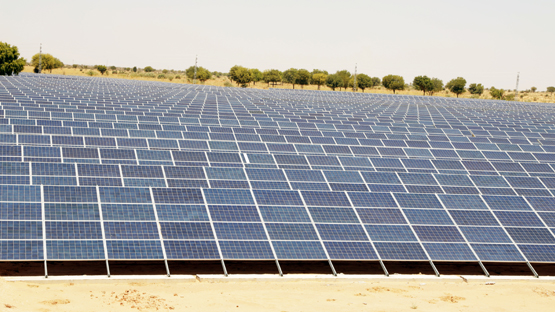Achieving the Sustainable Development Goals to end extreme poverty by 2030 will require about $4.5 trillion annually, far more than multilateral development banks or donors can provide by themselves. To face this challenge, the World Bank Group adopted the MFD approach, which entails working with governments to crowd in the private sector while optimizing the use of scarce public resources. This approach is guided by the Hamburg Principles adopted by the G20 in 2017 and builds on the substantial experience across the institution.
Developing clean, renewable energy is crucial for India as well as the planet. The government has pledged that 40 percent of India’s installed electricity capacity will come from renewable sources by 2030 as a part of its Nationally Determined Contribution (NDC) to the Paris Agreement. Solar power is crucial to achieving this and, with support from the World Bank, the government is making great strides to develop it. In collaboration, IFC has devised an innovative approach to attracting investors, which serves as a model for profitable solar generation.
Development Challenge
Scaling up renewable power in India is crucial. The country is the world’s third-largest emitter of CO2 and is also home to 13 of the world’s 20 most polluted cities. Demand for power is rising too—about 250 million people (a quarter of the population) lack access to grid electricity. Under the Paris Agreement, India has committed to producing 40 percent of its electricity from renewable sources by 2030. This will cost an estimated $150 billion—much of which is anticipated to come from private investors and is contingent on simplifying the energy sector’s regulations and improving transmission infrastructure.
The MFD Approach
Responding to the government’s request to help scale up renewable energy, the World Bank and IFC jointly supported developing solar power. This includes fostering innovative public-private partnerships, helping manage risk, and working to attract investors. As a result, the cost of producing solar energy has fallen substantially, spurring private investment and reducing tariffs for the end user.
Setting Up the Enabling Environment
In 2010, India committed to establishing 100 gigawatts (GW) of solar power capacity by 2022. But by 2015, only about 2 GW had been added, bringing the total solar capacity to less than 4 GW. Although solar plants can be profitable, investors had been discouraged by inadequate infrastructure, difficulty in obtaining land, a lack of familiarity with the sector, and perceived risks.
From 2015, the World Bank began supporting the government’s efforts to address these constraints by providing $100 million in concessional finance: a $75 million IBRD loan, a $23 million loan from the Clean Technology Fund (CTF), and a $2 million technical assistance grant from the CTF—a World Bank-administered fund for supporting low-carbon technology in developing countries (www.climateinvestmentfunds.org/topics/clean-technologies). This is helping to establish two large solar parks in Madhya Pradesh and develop the infrastructure to connect them to the grid and distribute power to consumers.
In parallel, the government worked on establishing fair and binding arrangements among the key sector players in solar energy—state and national agencies, state-owned enterprises, and private energy producers—as well as improving the regulatory and fiscal environment. This included doubling the portion of energy that large-scale consumers must source from renewables and raising the tax levied on coal-derived energy from less than 3 percent in 2016 to more than 17 percent in 2019.
Creating a Solar Power Market
A major outcome was the establishment of a bankable solar project for both domestic and international investors. Since 2015, IFC and the World Bank have coordinated their efforts closely and played a crucial role in attracting private investors to the solar industry and delivering the power at competitive prices.
IFC’s innovative approach was to make the Rewa Solar Park project “investment-ready” prior to auctioning its construction to developers. The objective was to demonstrate that large-scale solar projects can be implemented in a time-bound manner and attract commercial finance by systematically addressing risks.
Making a Difference
The Rewa Solar Park established a record low tariff for renewable energy—less than 5 cents per kilowatt hour. Competitive with power produced from non-renewable sources, the tariff has made new investments in coal plants far less attractive. This could not have been achieved without the efforts of IFC to create a bankable project for domestic and international investors, and support from the World Bank to make land and infrastructure available in a timely manner.
Of the $100 million the World Bank is investing in establishing solar parks in India, $18 million was dedicated to infrastructure for Rewa, which leveraged almost 32 times that amount in commercial investment ($575 million).
